Project of the 15XM “Storm” cruise missile
The start of active work on the missile theme in 1946 was accompanied by a mass of reorganizations. So, in order to simplify the development of new systems, it was decided to withdraw several departments from the research institute-1 of Minaviaprom, on the basis of which new institutes, design offices and factories were created. In particular, the result of this transformation was the appearance of OKB-293 at the plant number 293 in Khimki. Matus Rufimovich Bisnovat, previously actively involved in rocket technology, was appointed director of the plant and chief designer. At the new place of Mr. R. Bisnovat and his colleagues had to continue work on promising weapons.
At the end of 1947, the design bureau of plant No. 1 began work on the subject of guided missiles for the naval fleetdesigned to defeat enemy ships. The project involved the creation of a guided munition capable of achieving a target and independently aiming at it. The new development received the symbol 15XM. Design Bureau No. 1 was engaged in a new project for only a few months. Already in 1948, it was decided to transfer the creation of an anti-ship missile to OKB-293, which had some experience in creating missile systems. After the transfer to the new developer, the project received the code “Storm”.
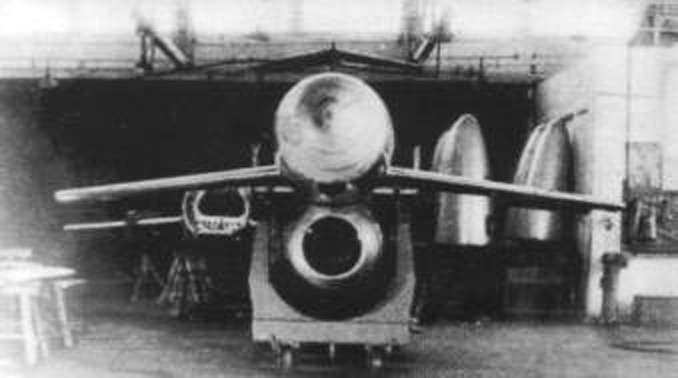
15XM rocket on a shipping trolley
Initially the team of M.R. Bisnovata continued work on the ideas embodied in the project submitted to him. However, a new version of the technical specification appeared later, which led to a serious reworking of the project. With the exception of some common features, the project was actually developed anew. At the same time, it was not only OKB-293 that had to develop the updated project. An important participant in the 15XM “Storm” project was OKB-3, headed by MM. Bondaryuk. His task was to create a power plant for the rocket. After changing the requirements, it was necessary to create a new engine with other characteristics.
In addition to the "motive" OKB-3, several other organizations were involved in the Storm project, whose task was to create certain elements of the complex. Thus, the development of missile control systems and the launcher was entrusted to the Scientific Research Institute-49 of the Ministry of Food Industry, the autopilot was made by Plant No. 181 of Minaviaprom, the homing heads of several types were designed at the Scientific Research Institute-10, Scientific Research Institute-20 and Scientific Research Institute-885, the design of the launcher was created by the Leningrad Kirov Design Bureau, the development of the starting accelerator was entrusted to KB-2 of the Ministry of Agriculture and Scientific Research Institute-1. Such cooperation allowed us to simplify and to some extent speed up the work.
To the project "Storm" rather strict requirements on the timing of implementation. Already by June, the 1949 of the year was required to submit the first batch of experimental missiles, and by the end of the year to begin their flight tests. During the factory and government tests planned to use 30 missiles with different guidance systems. Due to the complexity of the work in practice, the dates have noticeably moved. In addition, already during the design flaws in the existing proposals were revealed. Due to the complexity and the need for improvements to the beginning of 1949, only OKB-293 and several subcontractors fit into the schedule. In this case, for some additional projects there has been a serious backlog.
Design Bureau MR Bisnovata developed a glider rocket, but could not continue to work due to the absence of other components. For this reason, the tests began with the construction of several models of the 15XM rocket for various purposes. Large-scale (1: 2) copies were intended for transportation on the Tu-2 flying laboratory in order to study the behavior of the missile in flight. A full-scale mock-up mover was used to test the radio command control system. The launcher was tested using mock-simulators of the desired weight, equipped with solid-fuel boosters.
Another interesting means of testing the proposed ideas was the manned version of the projectile aircraft. Back in 1948, it was proposed to build a full-scale rocket model equipped with a pilot's cabin. The construction of such a device, called the “Product 19P”, started next year. It had a glider similar to a rocket, but equipped with a cockpit. The first 19P prototype was equipped with an RD-14 engine developed for Storm. The second received a less powerful engine RD-20.
In the 1950 year, “19P” first took to the air. Pe-8 bomber raised the prototype to 2000m height, then dropped it. "19P" included the engine and made an independent flight. Prototypes were tested by GM pilots. Shiyanov and F.I. Burtsev. Interestingly, the second prototype with a relatively weak engine could only plan with a decrease, since the thrust of the power plant did not provide horizontal flight. As part of testing the “19P Products”, 26 flights were performed: 17 flights of the main inspection program and 9 during an additional flight.
The main design features of the 15XM rocket were identified in the early stages of development and were only further developed for one reason or another. The final version of the project, prepared at the beginning of 1949, implied the use of an elongated cigar-shaped fuselage with a nacelle under the bottom. In the middle part of the fuselage, the wing was swept by 35 ° (along the ¼ chord line). In the tail of the fuselage placed T-shaped plumage with large sweep angles. On all planes located steering surfaces for control in flight.
The fuselage was divided into six compartments. The unified head compartment was designed to accommodate the homing equipment, its filling depended on the type of the GOS. In this case, the shape and size of the body were common to all equipment options. The second compartment was filled with control equipment and systems for the initiation of the warhead. The third was given to an explosive charge, and in the fourth they placed two fuel tanks, a tank for compressed air, and a part of electronics. Two tail bays also contained different elements of control equipment.
The total length of the Storm missile was determined at the level of 8,9 m with a maximum fuselage diameter of 0,9 m. Wingspan - 5,5 m. The total height of the product reached 2,75 m. The launch weight of the rocket was set at 4300 kg, of which 800 kg was accounted for the high-explosive warhead with contact fuse.

Layout missiles with radar homing. 1 - antenna unit GOS; 2 - GOS transmitter; 3 - Radiovision Unit; 4 - electric fuse and PIM; 5 - pin fuse; 6 - warhead; 7 - straight-through engine; 8 - tank number 1; 9 - compressed air cylinders; 10 - tank number 2; 11 - steering aileron; 12 - receiver GOS; 13 - radio altimeter unit; 14 - battery; 15 - steering wheel height; 16 - radio control unit; 17 - steering rudder; 18 - autopilot gyro unit; 19 - starter motor stabilizer; 20 is the starting engine.
Preliminary calculations carried out in the early stages of the project showed that the new rocket should be equipped with a ramjet engine. Such a power plant could develop the required power, and also differed from other systems by the relative simplicity of the design. On the basis of the characteristics of the ramjet, it was considered the best option for an anti-ship missile. Development of the product was commissioned by OKB-3, headed by MM. Bondaryuk.
In 1948, the RD-3 project was launched in OKB-700, which involved the creation of a direct-flow engine with a combustion chamber with a diameter of 700 mm. Further development began on the RD-1A engine, which was notable for a different geometry and enhanced performance. A flying laboratory based on the Tu-14 bomber was used to test the prototype engines. After testing and fine-tuning the maximum thrust RD-1A managed to bring to 1500 kg. The design life allowed the engine to run continuously for 10 minutes.
The RD-1А direct-flow engine was proposed to be installed in the engine nacelle under the rocket fuselage. It was planned to place the starting powder rocket engine in the back of the engine nacelle, as well as in the nozzle of the marching ramjet. This product is made in the form of a cylindrical block with nozzles in the tail section. To compensate for the change in balancing the rocket assembly, the starting engine received an N-shaped tail unit with a wide stabilizer. With a total weight of 1450 kg, the start-up engine had a charge of 526 kg with a mass and developed 3-4 tons of thrust during 25-35 with, providing the launch and initial acceleration of the rocket. After producing the fuel, the starting engine should have dropped out of the ramjet nozzle, allowing it to start work.
The first large-scale mock-ups of the 15XM product were equipped with a radio command control system, which allowed flight without the use of homing heads that had not yet been developed. To solve various combat missions, the Storm rocket was supposed to use three types of heads. So, the specialists of the Scientific Research Institute-20 were to create a radar seeker, the Scientific Research Institute-10 was assigned to design the infrared, and the scientific research institute-380 was to provide a television guidance system. Due to the imperfection of the technology of those years, the guidance equipment had to occupy a large volume and significantly increase the weight of the rocket. Thus, the radar GPS should weigh about 130 kg, thermal - 55 kg, and television - 70 kg.
In addition to the homing heads, the Storm missile was to be equipped with a radio altimeter, autopilot, and other systems responsible for flight control and signal conversion from the GOS to commands for steering gears. Various electronic equipment had to be located in several compartments of the rocket fuselage. The widespread use of radio tubes did not allow to reduce the size of the equipment and use a more dense layout using smaller volumes.
The Storm missile system was proposed to be used as a coastal system. For mounting on the firing position, a special rail launcher with 35 m-length rails was designed. The rocket should be mounted on the rails using four separate sliders mounted on the wing and tail unit of the starting engine. Before starting, the guide was turned in the direction of the meeting point with the target.
In 1951, together with the Central Research Institute-45 (now the Krylov State Research Center), the design of the ship’s launcher for the 15XM missiles began. The missile system was proposed for installation on destroyers of the project 30bis. By removing the main-caliber aft towers and part of the anti-aircraft weapons, a launcher for a rocket could be mounted on such a ship. In the holds in this case it was located up to 12 missiles. Also considered the option of installing "Storm" on the destroyers of the project 56. Such a ship completely lost its main-caliber artillery, but received two guides for missiles with ammunition in 16 products.
The installation of launch rails on light cruisers of the 68bis project was considered to be the most profitable and promising option for arming ships. In this case, on the site of the aft turret, a rotary armored unit with two launchers should be installed. In the protected volume of the ship it was possible to place up to 24 rockets. This option of equipping ships looked best, but it was not worked out in detail. Due to the delayed work on the Shkval complex, the modernization project for destroyers and cruisers was not developed or proposed for implementation.
In addition to the launcher and the rocket, several radar stations were to be included in the anti-ship coastal missile system. To simplify the work, it was decided to use only existing or developed products. Radar "Reef" was to produce the detection of surface targets. Accompanying the target and calculating the data for launching the rocket were assigned to the “Volley” station. The third radar, "Anchor", was to monitor the flight of the rocket and transmit data to the control system. A separate element of the complex received information about the target and the rocket, on the basis of which it developed commands for control over the radio channel.
The intended use of the 15XM rocket was as follows. The RIF radar detects a target and transmits data about it to the Zalp station. She takes the target on the support and provides a preliminary calculation of the trajectory of the rocket with the guidance of the launcher. This is followed by the launch of the rocket, which the Radar "Anchor" begins to follow. From the launcher rocket comes with a solid-fuel engine, which, after the development of fuel is reset. Having sped up, the rocket turns on the marching ramjet and with its help flies in the direction of the target. In view of the imperfection of the homing systems, a large part of the path to the target should be made by a command and control team. The detection and acquisition of the GOS target was to occur at a distance of no more than 12-15 km.
The minimum range of attack targets was determined at the level of 27 km. Maximum - 80 km. With the help of a ramjet type RD-1A, the Storm rocket could fly at speeds up to 270 m / s. The control equipment allowed to rise to a height of 1500 m, but before the meeting for the purpose of the last leg of the flight occurred at a height of about 9-10 m. For a flight to the minimum range, no more than 110 were required, with the maximum - about 300 s. When using a radar homing head, the target was detected at a distance of up to 15 km in a sector 30 ° wide, ranging from + 10 ° to -10 ° in a vertical plane. The characteristics of the other GOS differed slightly.
Due to the complexity of creating certain components of the missile complex, the beginning of the tests has seriously shifted. Until the end of 1951, a half dozen prototype rockets were built with standard powerplants. The second batch of 15 missiles was almost ready for delivery. At the same time, the manufactured prototypes had only radio command guidance equipment, since the production of some other components of the onboard equipment had not yet begun. It was only at the very end of 51 that autopilots and radio altimeters began to be mounted on the rockets.
Without waiting for the delivery of homing heads, Plant No. XXUMX and related organizations began preliminary tests of missiles. We checked the start with the existing launcher, as well as the possibility of using missiles from aircraft Pe-293 and Tu-8. Also worked out the work of radio control and telemetry. This work continued until the spring of 4, when 1952XM missiles with automatic control systems were launched for testing. At this stage, specialists had to face serious problems.
Missile launches from airplanes were successful and without significant problems. In the early summer of 52, the first rocket with electronics was launched on the Black Sea coast, in which a ground-based launcher was used. Two launches failed. As it soon turned out, the starting engine created an overload around 12 units, which simply broke all the onboard equipment. As a result, the rocket could not control its flight and fell into the water. After a number of improvements, the tests were continued and were accompanied by certain successes. For example, 6 September 1952, the rocket flew 22 km and only then fell into the sea due to system failure. In this case, most of the modified missiles fell near the launcher.
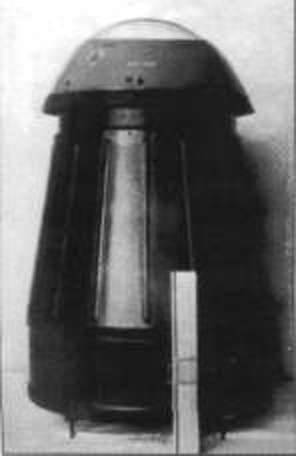
TV homing head designed for Storm
On October 27 of the same year, another test run was performed. This time the rocket was supposed to fly over the ground at a distance of 16,5 km. The product successfully took off and overcame a given route without any problems. Nevertheless, the analysis of telemetry showed that overloads at start continue to have a negative impact on the equipment and can still lead to breakdowns. Based on the results of this launch, it was decided to continue fine-tuning the systems, including with the reworking of the project. To do this was planned during the winter and in the factory. The following tests were appointed only in mid-April of the following year.
At the beginning of 1953, another escalation of the situation with intrigues in the defense industry occurred. Plant number XXUMX interested in the leadership of other organizations, which led to unpleasant transformations. February 293 The USSR Council of Ministers decided to transfer the plant number 19 to KB-293, which was headed by P.N. Kuksenko and S.L. Beria. The design bureau of the plant was disbanded, and its employees were distributed among other organizations. In the future, such transformations made it possible to create new missiles of various classes, but the fate of current projects was unenviable.
1 March 1953 year work on the project 15XM "Storm" were officially terminated. Documentation and built products were transferred to the new “owner” in the person of KB-1. By this time, the plant number 293 had two manned prototypes “19P”, 5 missiles with autopilot (10 had already been lost during tests) and 15 products with different types of GOS. In addition, another two dozen missiles were at different stages of production. All of these products were preserved and no longer used for their intended purpose.
In July, 1953, after well-known events in the highest circles of power, former employees of OKB-293 and colleagues MR. Bisnovata was sent a letter to the CPSU Central Committee in which they proposed to restore the design team and allow it to complete the development of the Storm complex. The issue was considered by the leaders of the defense industry and the armed forces. The possibility of completing the creation of a new missile weapon was an undoubted advantage of continuing the work. However, it took about a year to complete the restoration of Plant No. XXUMX and its design office. In addition, by the time the project was closed, the status of the 293XM project was unsatisfactory. There was a lack of a large number of necessary units, which could lead to another delay in work.
Thus, according to the most conservative estimates, it took at least two to three years to complete the development of Storm. In the meantime, the KOM-1 “Kometa” complex, created by A.I. The presence of a ready air-launched missile made it possible to develop the coastal missile system without much difficulty and as soon as possible. As a result, it was decided not to renew the project "Storm". The basis for the promising coastal complex was to be the KS-155 rocket. By the end of the fifties, the stationary coastal complex "Strela" and the mobile "Sopka", armed with existing missiles, were put into service.
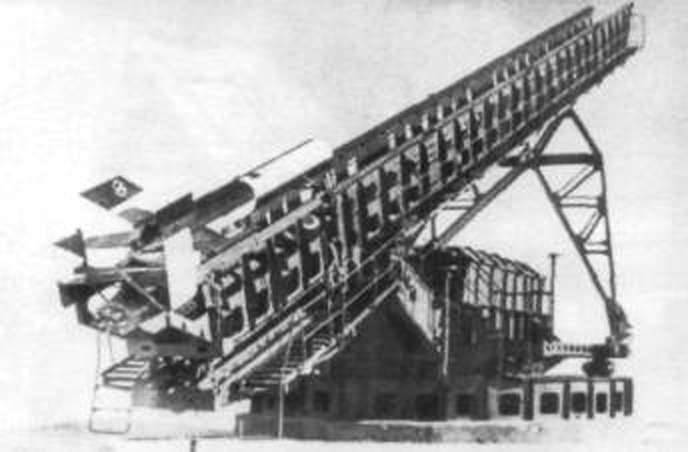
Rocket on coastal launcher
At the end of 1953, OKB-293 was founded on the basis of plant number 1 and several divisions of KB-2. Now this organization is called MKB "Fakel" them. P.D. Grushina. About a year later, M.R. Bisnovata was again returned to work on rocketry. Experts were assembled as part of OKB-4, which was entrusted with the creation of controlled aviation air-to-air missiles. The designers successfully coped with the task by developing a number of weapons. Later OKB-4 was renamed to KB Molniya, and in the mid-seventies it became part of NPO Molniya.
Despite the best efforts of many specialists, the anti-ship cruise missile 15XM "Storm" did not reach mass production and adoption. Development of this weapons turned out to be an extremely difficult task, because of which the work was delayed with the corresponding sad result. In addition, the intrigues of individual representatives of the defense industry prevented the completion of work at a certain stage. As a result, the troops received missile systems based on the KS-1 product and other similar systems, and the 15XM project was closed.
The Storm project did not lead to the expected results, however, it allowed the designers to gain valuable experience, which was later actively used to create new guided missile weapons. At the same time, despite the failure, the 15XM product left behind the honorary title of the first domestic coastal missile system with an anti-ship missile, which reached the test. It was the first step in a long and important way.
Based on:
http://missiles.ru/
http://alternathistory.com/
http://aviapanorama.su/
http://telenir.net/
Shirokorad A.B. Weapons of the domestic fleet. 1945-2000. - Minsk: “Harvest”, 2001
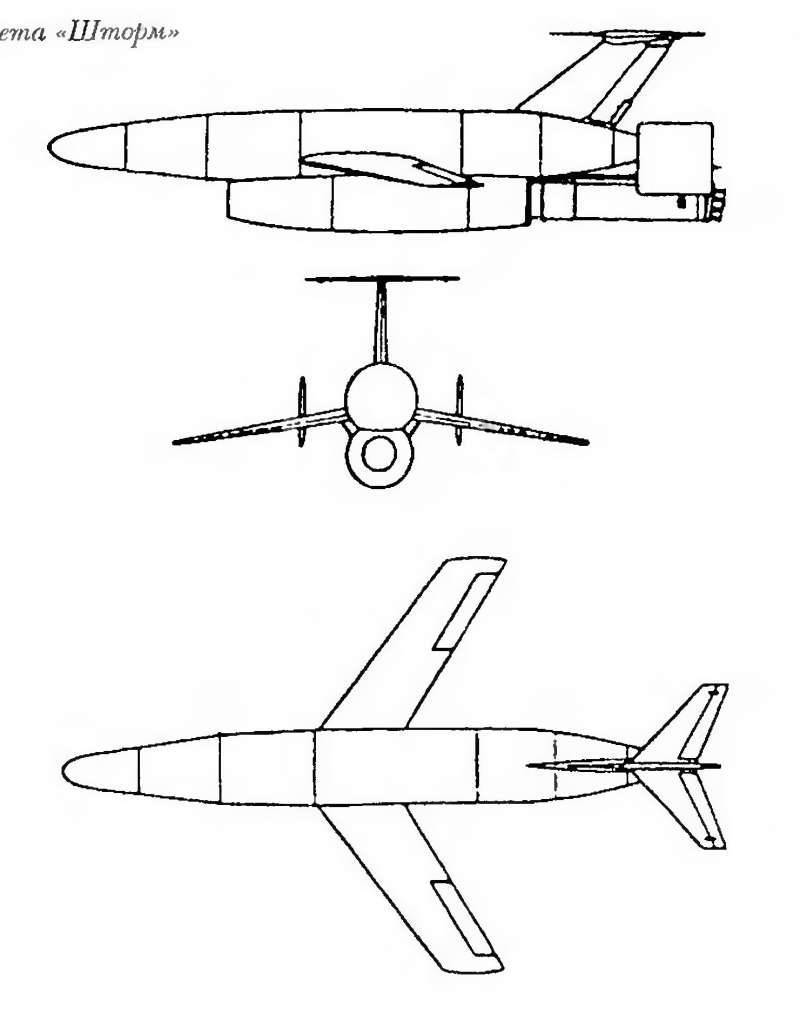
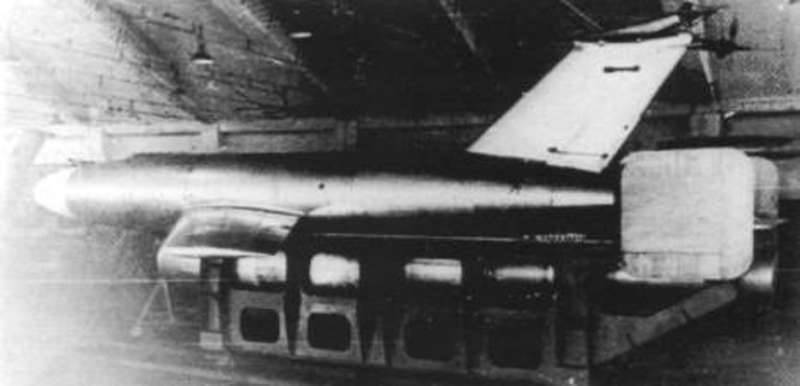
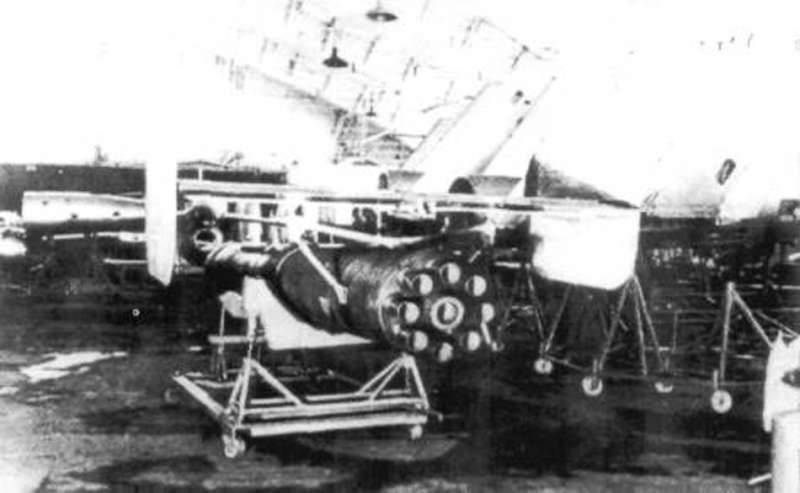
Information